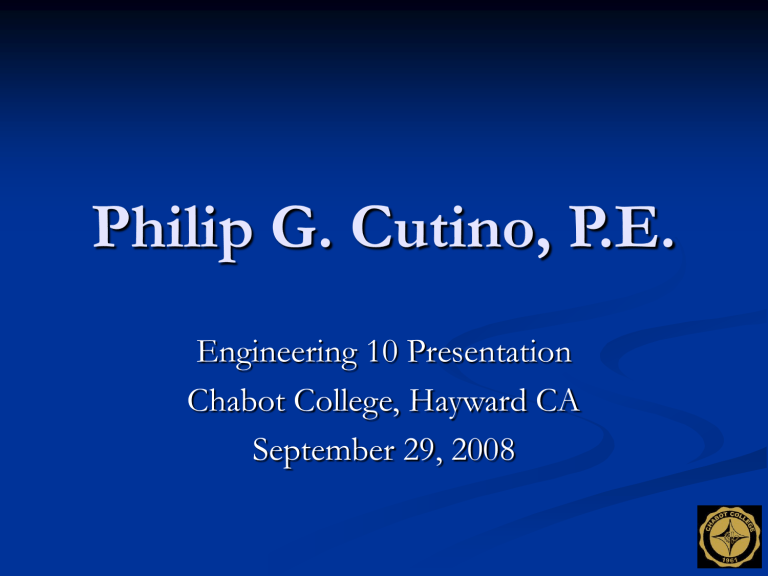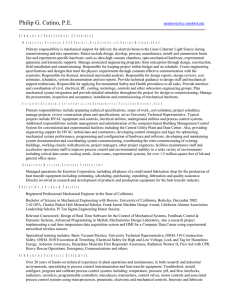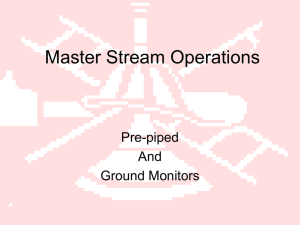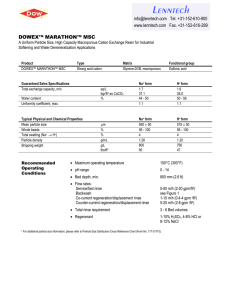Philip G. Cutino, P.E. Engineering 10 Presentation Chabot College, Hayward CA

Philip G. Cutino, P.E.
Engineering 10 Presentation
Chabot College, Hayward CA
September 29, 2008
Today’s Agenda
A little about me.
Stanford Linear Accelerator Center (SLAC)
Linac Coherent Light Source (LCLS)
My role at SLAC / LCLS
Some recent tasks
I am not a typical engineer
Mechanical Engineer
Register Professional Engineer in CA
Returned to school late in life
20 years hands-on work experience before engineering school
Diverse background . . .
20+ years with the same employer
I am currently enrolled at Chabot College!
Stanford Linear Accelerator Center
Location: Menlo Park, CA
Type: Multi-program Laboratory
Contract Operator: Stanford University
Website: www.slac.stanford.edu
Physical Assets:
426 Acres
145 Buildings
1.8M GSF in Active Operational Buildings
Human Capital
Employees: 1,496 FTE as of 4/15/08
Users, Visiting Scientists and Grad Students: 3036 Head
Count
SLAC Mission
Primary mission focus is designing, constructing, and operating state-of-the-art electron accelerators and related experimental facilities to advance the boundaries of scientific understanding.
Areas of Research
Development and application of ultrafast X-ray science
X-ray probes of the electronic and atomic structure of matter
Understanding the fundamental forces of nature and the physics of the birth and evolution of the universe
Advancing the world’s electron accelerator capability
Major Facilities at SLAC
The Linac Coherent Light Source (LCLS), currently under construction.
LCLS, the world’s first X-ray free-electron laser, positions SLAC to become the world leader in the exciting new field of ultrafast X-ray science.
The Stanford Synchrotron Radiation Laboratory (SSRL)
SSRL provides a resource to the user community for probing the electronic and atomic structure of matter.
The B-Factory
An electron-positron collider, completed operations in FY08, but an intensive data analysis program will continue for several years.
The Fermi Gamma-Ray Space Telescope (FGST)
SLAC is home to the Instrument Operations Center for the Large Area
Telescope instrument on FGST formerly know as the Gamma Ray Large
Area Space Telescope (GLAST)
Linac Coherent Light Source
Ultrafast X-ray science
Directly observe the motions of atoms on ultrafast time scales
Investigate dynamics, bonding, heating and melting, at atomic and nanometer length scales
Create and observe extreme new conditions in atoms and materials
Imaging of nonperiodic molecules and nanostructured materials
World’s first X-ray free electron laser
Producing 100 femtosecond pulses of photons in the energy range 800-
8,000 eV
10^ 12 coherent X-ray photons/pulse
Potential for sub-femtosecond pulses
Lead nanoscale science revolution
Master control of energy-relevant complex systems
Lead the world in the investigation of dynamics of atomic transitions, chemical bonding, catalysis and heating
Source: Wikipedia
LCLS
Linac 1003 meters
708 devices
Total Machine* : ~1750 meters of beam line 1242 Devices
Injector: 28 meters of beam line & 95 devices
LTU & Dump
408 meters
176 Devices
*Electron Beam Line Only
Does not include Photon Beam Lines
LCLS Construction Photos
LCLS Construction Photos
LCLS Construction Photos
LCLS from Google Maps
My Role at SLAC/LCLS
Primary responsibility is mechanical support for delivery of electrons from Linac to Beam Dump for
LCLS
Mechanical support for physicists, technicians and users
Diagnostics, BPMs, OTRs, Dumps
Magnets
Vacuum Chambers
LCW (water cooling systems for magnets, collimators, dump)
Recent Tasks
Commissioning Engineer for Injector through L3
4 RODs ranging from 2 days to 2 weeks
Commissioning Engineer for LTU & Dump areas
Design LCW distribution to devices in LTU
Flow Restrictors
Design LCW cooling system for the RF Gun
$1.2M project
2 new water systems
Tight temperature control requirements
High reliability design
Calculate Pressure Drop
Pressure Drop Calculation Continued
Flow Restrictors
Injector Vault – RF Gun
Injector Vault Work
RF Probe Change
Diagnostics Repair
New Laser Cooling System (LCS)
Serves lasers and RF Gun cooling system
Replaces temporary chiller outside Sector 20 laser room
System Flow: 40 GPM @ 70 PSIG
Supply temperature 56 °F (13.3 °C) ± 0.5 °F (0.9 °C)
Temperature based on dew point just outside of Laser Room Envelope (68
– 72 °F; 50% RH ± 5%)
Chiller Optimized to Run at Part Load.
N+1 pumps and compressors – automatic lead/lag
Heat Rejected to CT1202
Control System: CEF DCS except Chiller (DDC)
Both systems make data available to EPICS
Location: South Side Klystron Gallery between columns 9 & 12
Power source: new 480 V outdoor dist. panel Sector 21
September 8, 2006
LCLS Injector through BC1 Process Water FDR
Phil Cutino pcutino@slac.stanford.edu
Requirements Driving LCS Design
Drive Laser
Maximum Load: 11 kW (with 2 Lasers)
3 ThemoTek Chillers per laser
1 Cryomech Compressor per laser
Initially only about 1 kW
No Condensation Inside Laser Room
Dew Point < 56 °F at 72.9 °F DB; 55% RH
14.2 GPM
RF Gun Cooling System
25 GPM
RF Gun LCW Setpoint as low as 64.4 °F (18 °C)
Up to 24 kW heat load as low as 9 kW
September 8, 2006
LCLS Injector through BC1 Process Water FDR
Phil Cutino pcutino@slac.stanford.edu
Laser Room Cooling System (LCS)
CTWR
85 °F
CTWS
75 °F
10 Ton Chiller
(optimized for part load operation)
N+1 Compressors
48
°F
Chilled Water
Buffer Tank
30 GPM
30 GPM
September 8, 2006
LCLS Injector through BC1 Process Water FDR
TT-2
56 °F
40 GPM
40 GPM
To/From
Process
2.5 to 10 tons
Phil Cutino pcutino@slac.stanford.edu
New LCLS Injector Water System (ICS)
Two Pumps, each capable of ~80 GPM @ 125 PSIG
Base-line design is for 60 GPM incl. polishing loop
One will run at a time with automatic lead/lag
Supply Temp 78.5 ± 0.5 °F (25.8 ± 0.9 °C)
Plate Heat Exchanger sized to reject 480 MBH
Heat rejected to CT1202
Control System: CEF DCS (AB Control Logix PLC)
All input values available via EPICS
Location: south side of Klystron Gallery between col. 5 & 7
Power Source: new 480 V outdoor dist. panel
Operational by December 1, 2006
September 8, 2006
LCLS Injector through BC1 Process Water FDR
Phil Cutino pcutino@slac.stanford.edu
Requirements Driving New LCW System
RF Gun
4 KW heat rejected
SP range 64.4 °F to 113 °F (18 to 45 °C)
Temperature Stability ±0.45 °F (0.25 °C)
Flow 9.2 GPM
Magnets
~45 GPM
80 to 100 PSID
Load Lock / Work Area
80.6 °F (27 °C) maximum
RF Hut
95 °F ± 0.13 °F ((35 °C ± 0.07 °C)
September 8, 2006
LCLS Injector through BC1 Process Water FDR
Phil Cutino pcutino@slac.stanford.edu
Injector Cooling System (ICS)
TT
78.5 °F
TT
TT
75 °F
CT1202
Surge
Tank
78.5 °F
2 New Pumps each ~80 GPM
@ 125 PSIG
10 micron filter
New Pump Pad
Heater
93 °F
TT
97 °F
TT
95 °F
±0.13 °F
Sector 20 Klyston Gallery
Continued on next slide
September 8, 2006
LCLS Injector through BC1 Process Water FDR
TT
88.5 °F
TT
84 °F
15 GPM
To RF Hut
Electronics
Heater & Valve
Mounted East
Wall of RF Hut
(Outside)
Phil Cutino pcutino@slac.stanford.edu
Continued from previous slide
DPS
Injector Cooling System (cont.)
BX01
0.52 GPM
BX02
0.52 GPM
QB
0.7 GPM
BXS
1.42 GPM
BX11
1.69 GPM
Sector 21 Linac Housing
BX12
1.69 GPM
BX13
1.69 GPM
BX14
1.69 GPM
Load Lock Area
3 GPM
Loading & Work Area
3 GPM
Sector 20 Laser / Injector Facility
Continued on next slide
Laser Room LCW
September 8, 2006
LCLS Injector through BC1 Process Water FDR
Phil Cutino pcutino@slac.stanford.edu
Injector Cooling System (cont.)
Continued from previous slide
Set Point = A + 3
Cooling
Heat Exch.
TT
Set Point = A - 3
Heat
Recovery
Heat Exch.
TT
Heater
DPS
TT
56 °F
TT
DPS
Chilled Water
~ 25 GPM
TT
** LCLS Controls to provide setpoint signal only
Set Point (A) Reset on RF Gun Power
RF Gun Cooling – 10 GPM
64-113
± 0.45 °F
(18-45
±0.25 °C)
Gun Solenoid
3.6 GPM
September 8, 2006
Future
LOA Solenoid
2 GPM
BXH1
1.1 GPM
Sector 20 Injector Vault
LCLS Injector through BC1 Process Water FDR
BXH2
1.1 GPM
BXH3
1.1 GPM
Phil Cutino pcutino@slac.stanford.edu
BXH4
1.1 GPM
RF Gun Simple Scheme
SP –2°C
Set Point (SP)
Range: 18-38 °C
TCV-1
TT-1 TT-2
TCV-2
CHWR
13.3 °C
Process Water to / from RF Gun
HTX-1
CHWS
7.8
°C
Injector Water
10 GPM
SP +2
°C
TT-3
Electric
Heater
September 8, 2006
LCLS Injector through BC1 Process Water FDR
Phil Cutino pcutino@slac.stanford.edu
Simple Temperature Profile for Control Valve
103
°F
100.2
°F
(38
°C)
97
°F
97
°F
93
°F
78.5 °F
(25.8 °C)
Leaving
Heater
Leaving
3-way Valve
Leaving
Htx 1
(27 kW added)
64.4
°F
(18 °C)
16
°C
64.4 °F
(18
°C)
RF Gun Water Set Point
September 8, 2006
LCLS Injector through BC1 Process Water FDR
93
°F
(33.9
°C)
100.2
°F
(38
°C)
Phil Cutino pcutino@slac.stanford.edu
Chilled
Water
Supply Temp
56
°F(13.3°C)
~25 GPM
RF Gun Water Control
Set Point (SP)
Range: 64.4-113 °F
(18-45 °C)
SP -4.5 °F
(2.5 °C)
TT
Process Water to / from RF Gun
4kW (max)
TT
Heat
Recovery
HTX-2
HTX-1
SP +4.5
°F
(2.5
°C)
TT
20 kW
Electric
Heater
Injector
Water
10 GPM
78.5
°F
September 8, 2006
LCLS Injector through BC1 Process Water FDR
Phil Cutino pcutino@slac.stanford.edu
103
°F
100.2
°F
(38
°C)
97
°F
Improved Temperature Profile
93 °F
96
°F
90 °F
78.5 °F
(25.8 °C)
Leaving
Heater
Leaving
3-way Valve
Leaving
Htx 1
6.6 kW Heating
4.4 kW Cooling
~11 kW Total
64.4
°F
(18 °C)
61.4
°F
64.4 °F
(18
°C)
RF Gun Water Set Point
September 8, 2006
LCLS Injector through BC1 Process Water FDR
93
°F
(33.9
°C)
100.2
°F
(38
°C)
Phil Cutino pcutino@slac.stanford.edu
RF Gun Cooling System Response
Modeling by Claudio Rivetta
September 8, 2006
LCLS Injector through BC1 Process Water FDR
Phil Cutino pcutino@slac.stanford.edu
Photos of Water System
Construction
More Water System Photos
Finished Pump Pads
My Advice to Perspective Engineers
Effective Communication is very important
Credibility is your most important asset
First impressions are important
Engineering design, like life, is a series of compromises, you need to balance the priorities of the project with available resources
Engineering IS problem solving
Questions?
Links to More Information:
http://www.slac.stanford.edu
http://lcls.slac.stanford.edu
http://www2.slac.stanford.edu/vvc/





